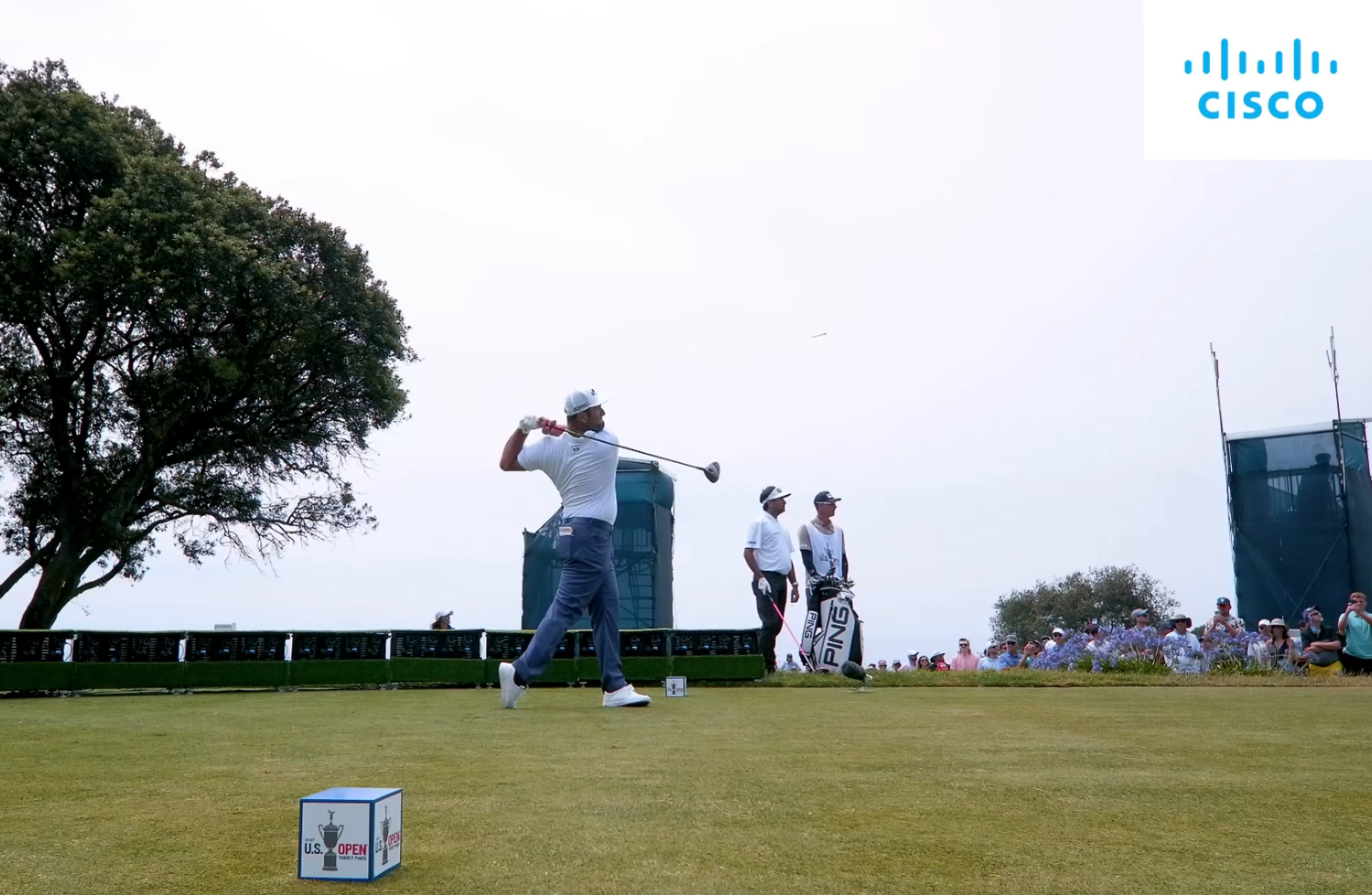Jon Rahm. The 2021 United States Open champion. It has a nice ring to it. Rahm, who outlasted the field at Torrey Pines Golf Course (South) in San Diego, is the first Spaniard to capture the U.S. Open.
It’s been a memorable month along the California coast for the United States Golf Association (USGA) as well. It conducted two stellar national championships—the U.S. Open and U.S. Women’s Open, which took place in early June in San Francisco. During both tournaments, the USGA collaborated with corporate partner Cisco and 4DReplay to bring first-of-its-kind interactive 4D swing technology to users’ fingertips. At Torrey Pines, 88 cameras were positioned around the perimeter of the 6th tee. As players teed off the dogleg-right par-4, their swings were captured in 4D. And, in a flash, the 4D swings appeared on the USGA’s U.S. Open mobile app.
Fans who download the U.S. Open app (or U.S. Women’s Open app) can enjoy—and learn—from the 4D swings. Even the contestants themselves are getting a kick out of it. “The 4D camera view of my swing was pretty awesome,” said Danielle Kang, currently sixth in the Women’s World Golf Ranking. “Being able to see my swing in a continuous motion from every angle can be very informative and I believe is a great addition to the U.S. Open.” You can check out Kang’s swing HERE, accompanied by expert instruction.
Users can start and stop the swing videos on demand, and on the mobile app, choose from 34 different camera angles. All of it is made possible by Cisco’s industry-leading networking capability. In addition, Cisco, the Official Technology Partner of the USGA, provided the connectivity for the 4D swings to be seamlessly transferred from the 6th tee to NBC’s on-site production center, where images were dropped into the live U.S. Open telecast. “Cisco is delivering new opportunities for fans to connect with players, to get closer to the action and to experience golf in a new way,” said Ashley Marusak, Global Lead, Sports Marketing, Cisco. “The 4D video technology is an innovative solution helping to make it possible. With the technology on display within the USGA mobile app, NBC broadcast and across social media channels, the fans experienced this year’s U.S. Open in a way that wasn’t previously possible.”
For a taste of the action, we’ve highlighted the 4D swings with five PGA TOUR stars—Jon Rahm, Brooks Koepka, Rory McIlroy, Matthew Wolff and Bryson DeChambeau. (All Tour stats and rankings are as of June 21, 2021.) Each video contains tips and analyses from Steve Scott, Director of Instruction, Golfweek. Scott, one might recall, had a legendary duel with Tiger Woods in the U.S. Amateur final at Pumpkin Ridge GC. Woods won the match-play classic—25 years ago!— in sudden death on the 38th hole. Relive the coolest moments in Scott’s new book, “Hey, Tiger—You Need to Move Your Mark Back.”
Jon Rahm
BIO: No. 1 Official World Golf Ranking; No. 1 PGA TOUR Official Money List; No. 2 FedEx Cup; No. 21 Average Driving Distance (307.6 yards); No. 2 Strokes Gained: Off-the-Tee; 6 PGA TOUR titles; 1 Major.
4D SWING: Saturday, Round 3. Hole measured 534 yards.
BACKGROUND: Rahm came to No. 6 at -3. He hit driver 327 yards into the first cut of rough, leaving 206 yards to the hole. The approach shot found the green 36 feet from the cup. Two-putt par. Rahm would post -2 through three rounds. The final round 4-under par (67) vaulted Rahm to his first Major.
TAKEAWAYS
00:00:00 to 00:00:03 — The new U.S. Open champion shows the trigger that initiates a compact, powerful swing. A slight forward press with a neutral grip is how he starts the club in motion from a stagnant position.
00:00:04 to 00:00:06 — Even though the hands don’t get way above the head, Jon’s storing power in massive legs that are waiting to be shifted to and through impact.
00:00:06 to 00:00:08 — Jon’s lack of flexibility in the thoracic spine causes a shorter backswing. The bowed (bent forward) left wrist helps to square the clubface at the top. With a flat wrist, Jon’s clubface would be open at the top and require a compensating move on the downswing to square it up.
00:00:09 to 00:00:11 — Jon’s power move. The legs and hips are pulling the shoulders and hands around to impact, which means the stored power in his lower body doesn’t get lost.
00:00:12 to 00:00:13 — Notice that both heels are off the ground at impact, and all the weight has pushed to the toes. It’s difficult to play any sport well if the weight sits back on the heels too much. The left wrist maintains its bowed position, which keeps the clubface de-lofted through impact. I love that position.
00:00:14 to 00:00:17 — The right arm doesn’t straighten until after impact. Jon swings through the ball, not to the ball.
00:00:18 to 00:00:21 —Jon’s compact windup and massive explosion through the ball lead to a slingshot-like finish.
Next up: Brooks Koepka

